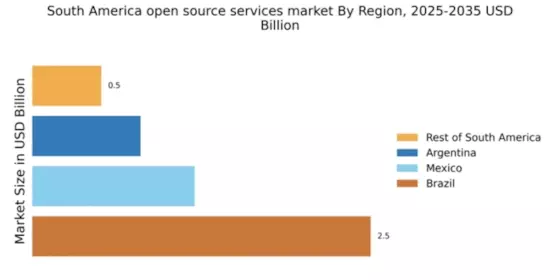Emergence of Localized Solutions
The open source-services market in South America is increasingly characterized by the emergence of localized solutions. As businesses strive to cater to regional preferences and regulatory requirements, there is a growing demand for software that is specifically designed for local contexts. This trend is particularly relevant in sectors such as education, healthcare, and finance, where compliance with local laws is paramount. In 2025, it is expected that localized solutions could account for around 15% of the market, reflecting the importance of cultural and regulatory alignment. By focusing on local needs, companies can enhance user adoption and satisfaction, thereby driving growth in the open source-services market. This localization trend underscores the necessity for service providers to adapt their offerings to meet the diverse needs of South American consumers.
Growing Demand for Customization
The open source-services market in South America experiences a notable increase in demand for customization. Businesses are increasingly seeking tailored solutions that align with their specific operational needs. This trend is driven by the recognition that one-size-fits-all solutions often fall short in addressing unique challenges. As a result, companies are turning to open source services, which offer the flexibility to modify and adapt software according to their requirements. In 2025, it is estimated that the customization segment could account for approximately 30% of the overall market share, reflecting a shift towards personalized service offerings. This growing demand for customization is likely to propel the open source-services market forward, as organizations prioritize solutions that enhance efficiency and effectiveness.
Increased Focus on Cost Efficiency
Cost efficiency remains a critical driver in the open source-services market in South America. Organizations are increasingly aware of the financial benefits associated with adopting open source solutions, which often come with lower licensing fees compared to proprietary software. This cost advantage is particularly appealing to small and medium-sized enterprises (SMEs) that operate on limited budgets. In 2025, it is projected that the cost savings from open source services could lead to a market growth rate of around 25%. Furthermore, the ability to leverage community support and resources further enhances the cost-effectiveness of these solutions. As businesses continue to seek ways to optimize their expenditures, the open source-services market is likely to thrive, driven by the pursuit of affordable yet robust software solutions.
Rising Interest in Collaborative Development
The open source-services market in South America is witnessing a surge in collaborative development initiatives. Organizations are increasingly recognizing the value of community-driven projects, which foster innovation and accelerate software development. This collaborative approach not only enhances the quality of software but also reduces time-to-market for new solutions. In 2025, it is anticipated that collaborative projects could represent approximately 20% of the total market, as companies engage with open source communities to co-create solutions. This trend indicates a shift towards shared responsibility in software development, where businesses leverage collective expertise to address common challenges. The emphasis on collaboration is likely to strengthen the open source-services market, as organizations seek to harness the power of community engagement.
Advancements in Technology and Infrastructure
Technological advancements and infrastructure improvements are pivotal drivers in the open source-services market in South America. The region is experiencing a digital transformation, with increased internet penetration and enhanced connectivity facilitating the adoption of open source solutions. As cloud computing and mobile technologies continue to evolve, businesses are better positioned to leverage open source services for their operations. In 2025, it is projected that advancements in technology could contribute to a market growth rate of approximately 35%. This growth is indicative of the increasing reliance on digital tools and platforms, which are essential for modern business practices. The ongoing improvements in infrastructure are likely to bolster the open source-services market, as organizations seek to capitalize on the benefits of innovative technologies.


















Leave a Comment